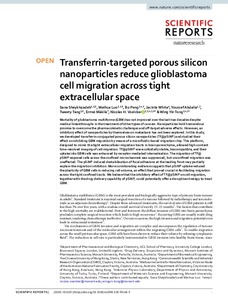Transferrin-targeted porous silicon nanoparticles reduce glioblastoma cell migration across tight extracellular space
Sheykhzadeh S.; Luo M.; Peng B.; White J.; Abdalla Y.; Tang T.; Mäkilä E.; Voelcker N.H.; Tong W.Y.
https://urn.fi/URN:NBN:fi-fe2021042827421
Tiivistelmä
Mortality of glioblastoma multiforme (GBM) has not improved over the
last two decades despite medical breakthroughs in the treatment of other
types of cancers. Nanoparticles hold tremendous promise to overcome the
pharmacokinetic challenges and off-target adverse effects. However, an
inhibitory effect of nanoparticles by themselves on metastasis has not
been explored. In this study, we developed transferrin-conjugated porous
silicon nanoparticles (Tf@pSiNP) and studied their effect on inhibiting
GBM migration by means of a microfluidic-based migration chip. This
platform, designed to mimic the tight extracellular migration tracts in
brain parenchyma, allowed high-content time-resolved imaging of cell
migration. Tf@pSiNP were colloidally stable, biocompatible, and their
uptake into GBM cells was enhanced by receptor-mediated internalisation.
The migration of Tf@pSiNP-exposed cells across the confined
microchannels was suppressed, but unconfined migration was unaffected. The pSiNP-induced
destabilisation of focal adhesions at the leading front may partially
explain the migration inhibition. More corroborating evidence suggests
that pSiNP uptake reduced the plasticity of GBM cells in reducing cell
volume, an effect that proved crucial in facilitating migration across
the tight confined tracts. We believe that the inhibitory effect of
Tf@pSiNP on cell migration, together with the drug-delivery capability
of pSiNP, could potentially offer a disruptive strategy to treat GBM.
Kokoelmat
- Rinnakkaistallenteet [27094]
